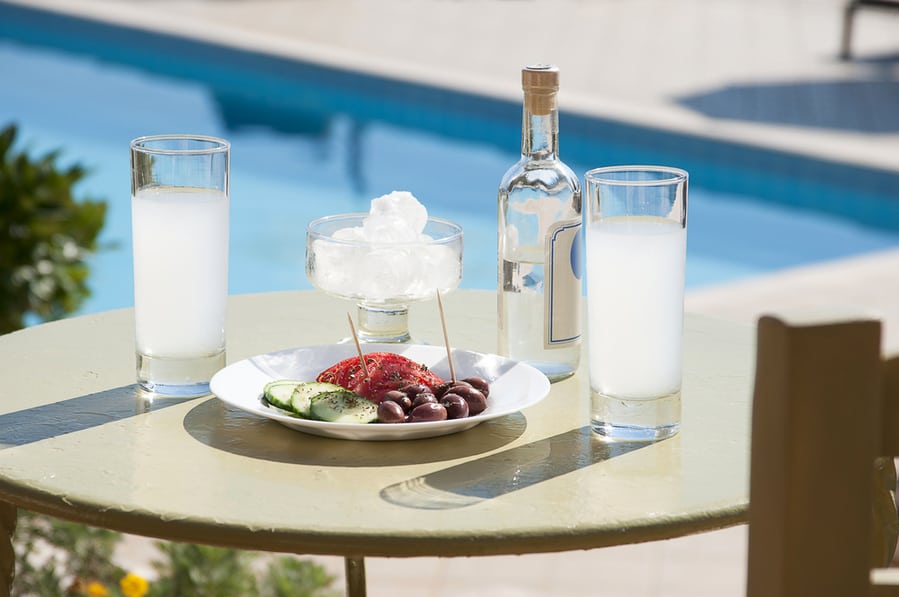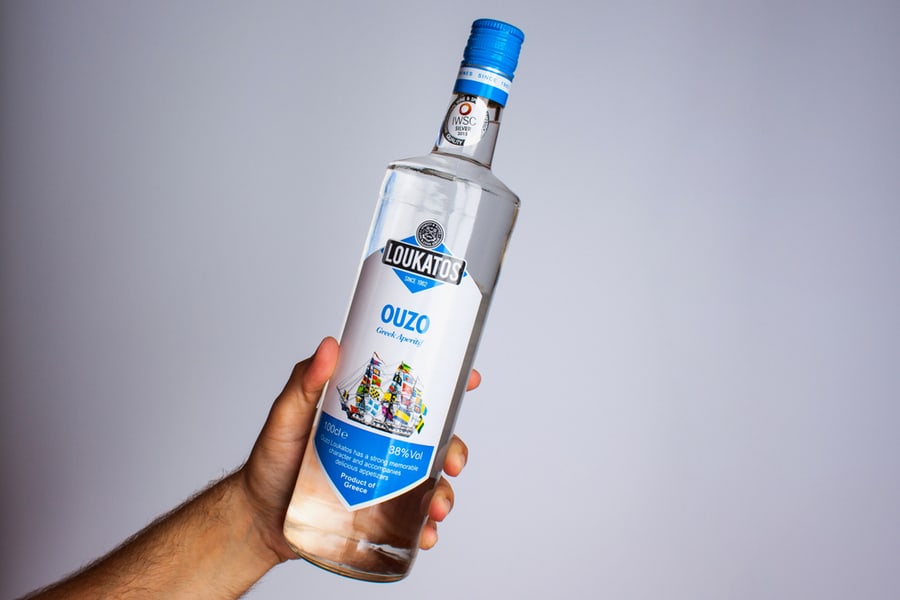
If you’re considering a vacation to Greece, you’ve probably heard of Ouzo, a potent alcoholic drink. This anise-flavored liquor is a famous Greek drink that may be found at any Greek restaurant, supermarket or food tour around Greece.
No other beverage is as closely related to Greece as Ouzo, but you might wonder, how do you drink Ouzo?
Ouzo is traditionally poured into tall, slim glasses, followed by cold water and/or ice. This allows the spirit to cool while retaining its aromas. Ouzo is always served with Greek meze and never drunk on an empty stomach.
First, we’ll examine what Ouzo is, and then we’ll give you a primer on what Ouzo tastes like before offering some valuable advice on how to drink Ouzo. We’ll also look at the health benefits of Ouzo and its dietary components.
What Is Ouzo?

Ouzo is claimed to originate from a myth about an Italian trading firm that bottled a quantity of tsipouro perfumed with anise. The boxes were labeled ‘uso Massalia‘ (‘for use in Marseille), becoming a ‘slogan’ for high-quality anise-flavored tsipouro.
Over time, Ouzo became recognized as a separate drink. In its early history, Ouzo was primarily a regional beverage. Because of its increasing popularity, traditional tsipouro became known as Ouzo.
Ouzo’s popularity skyrocketed following international absinthe prohibitions in the early twentieth century. Because it was less expensive than raki or arak, Ouzo rapidly became a favorite, with sambuca as a replacement anise-flavored (or licorice-flavored) drink.
Ouzo was commercially distilled for the first time in 1856. It is only produced in Greece and Cyprus.
The Greek government obtained exclusive rights to use the product name Ouzo in 2006. It is protected by the European Union’s PGI (Protected Geographical Indication) and PDO (Protected Designation of Origin).
The island of Lesvos takes pride in being the center of Ouzo production, representing half of the nation’s gross domestic Ouzo output from 17 distilleries. It is also well-known for producing some of Greece’s greatest Ouzo.
Although some recipes for distilling Ouzo are identical, most are secret family recipes.
How To Drink Ouzo
Every drink has its traditions and peculiarities, and Ouzo is no exception. Don’t fear. We’re here to help you do it right without embarrassing yourself in front of your guests or hosts.
What Does Ouzo Taste Like?

Before we (or you) dive into a lovely glass of Ouzo, we should be prepared for the taste explosion we will experience. Ouzo has a strong aniseed flavor, as we’ve explained earlier. Nevertheless, high-quality Ouzo may have aromatic characteristics due to the additional herbs and spices used in its production.
Ouzo will frequently taste the same, whether distilled from grapes or grain. Similarly, if sugar has been added (as they do in southern Greece), it may occasionally be slightly sweet.
Nonetheless, because anise has a high level of astringency, it will always have a dry mouthfeel. When drunk neat, Ouzo may be rather potent and overwhelming. Nonetheless, it is virtually always diluted with a bit of water.
How To Drink Ouzo Correctly

The act of drinking Ouzo is ritualistic for Greeks. This potent alcohol is sipped as an aperitif, stimulating the salivary glands and digestive system and priming one’s appetite for the main course. That feature alone makes Ouzo drinking a communal activity.
Ouzo is not to be drunk with the main meal because it doesn’t complement any main Greek dishes—Greeks enjoy wine or beer with their meals. Ouzo is to be savored and enjoyed over a few hours; don’t rush the drinking ritual.
“To our first” is a typical toast that groups will offer each time their glasses are refilled.
Food Pairings
The goal is to experience fun taste combinations through the little accompanying dishes or mezedes: grilled octopus, salty sardines, shrimp, shellfish, soft mizithra cheese, mint pastries, various dips, beans, and other finger foods.
Best Time To Drink
Ouzo has its own time and place; usually, late afternoon or early evening is the best time for serving and drinking Ouzo.
Serving Temperature
Ouzo is meant to be cold but should not be refrigerated—place one or two ice cubes in a small glass and pour a small amount of Ouzo over the ice. You could also run a little Ouzo in a glass and add ice-cold water to the glass instead of using ice cubes.
Take Small Sips
Taking shots of Ouzo is exceptionally stupid and defies the purpose of drinking Ouzo—relaxing and chatting with people who are dear to you. And you’ll have a hangover from the depths of Hades the next day if you go the Ouzo shot route.
Serving
Ouzo is traditionally served in tall, slender glasses, with the Ouzo being poured first, followed by cold water and ice. This allows the spirit to cool gently while preserving all of its smells (some experts think adding ice to Ouzo is blasphemy and best avoided).
On the other hand, some experts believe that the water should be put before the ice cubes and that it should not be too cold. This method’s temperature is progressively dropped, allowing the aromas and tastes to develop.
A sealed bottle, at room temperature, is placed on the table. Guests are expected to pour a tiny quantity into a tall glass filled with ice cubes and then top it up with water from a nearby jug.
Personal choice governs the amount of water used. Some individuals will dilute it till it louches (turns milky, also known as the Ouzo effect).
The Ouzo Effect
No, it is not a fancy name for a hangover when you’ve taken Ouzo shots (which we warned you about already!). The natural oils in anise and fennel seed, which provide a distinctive licorice scent and flavor, are soluble in high-quality, plain Ouzo.
When added water or ice is present, the alcohol concentration decreases, and the natural oils are released as a white precipitate, or louche. Absinthe, pastis, and sambuca will also turn milky when they come in contact with water or ice.
Along with the color shift, the degree of aroma produced rises, flooding the senses with their beautiful smells and tastes.
Ouzo and Your Health
A moderate quantity, like other alcoholic spirits, can help the gut absorb iron from meals and lower blood pressure through dilation of the blood vessels. The Ancient Greeks believed anise had health properties that helped relieve pain, made urinating easier, and decreased thirst.
On the other hand, anise is a common carminative that helps calm the digestive system, reducing bloating and gas.
Similarly, the anise in Ouzo may have antispasmodic properties that help to relieve cramps, convulsions, and diarrhea. Of course, as with any potent drink, any advantages will be obtained only in moderation. The negative consequences of excessive drinking will undoubtedly exceed them!
Grain alcohol technically does not contain gluten because the protein is eliminated during the distillation process. On the other hand, people with celiac disease have reported problems even with triple-distilled vodka.
However, grape-based Ouzo will not contain any gluten. The main problem is that only some companies publicly say if the alcohol base is derived from grapes or grain.
Meanwhile, based on the amount of sugar used, a shot of Ouzo might have somewhere around 100 and 110 calories. Similarly, it will include 10 to 15 grams of carbs.
How Is Ouzo Made?

Ouzo is created in the same way as tsipouro, the Greek counterpart of Italian grappa. Tsipouro has long been produced in Greece and is a brandy distilled from the must or remains (skins, seeds, twigs, etc.) of grapes pressed for winemaking.
A 96% ABV alcohol is distilled from the grape must then steeped with star anise and other spices such as fennel, cardamon, coriander, cloves, cinnamon, mint, and mastic, among others. According to Greek legislation, the completed distillate must include at least 20% of the original Ouzo yeast.
However, less expensive Ouzo may be prepared by combining the Ouzo yeast with another neutral alcohol and adding anise flavorings. Greece enacted legislation prohibiting the sale of Ouzo with less than 20% Ouzo yeast and bottled at a minimum of 37.5% ABV or 75 proof to preserve the industry.
The majority of Ouzo is approximately 80 proof. While it may appear moderate compared to high-proof whiskeys and rums, Ouzo is solid and spicy.
The high sugar content slows the absorption of alcohol into your system, which means you should drink Ouzo with caution because the alcohol’s effects will be subtle at first.
In southern Greece, Ouzo is sometimes sweetened with sugar, while the style is typically dry in the north.
Conclusion
Now you can drink Ouzo with confidence. Remember, Ouzo should be enjoyed with strong-tasting foods such as spiced sausages, seafood, salty nuts, and the like.
Ouzo is poured into small glasses, depending on how you like to serve it—either Ouzo topped up with cold water or Ouzo over ice. Whichever way you prefer to drink it, remember it is not a drink you rush.
Take your time, enjoy the company, and chat about everything and anything with friends or loved ones over some Greek meze.









